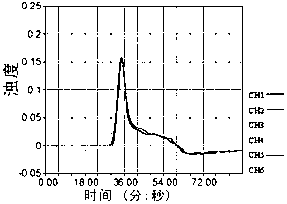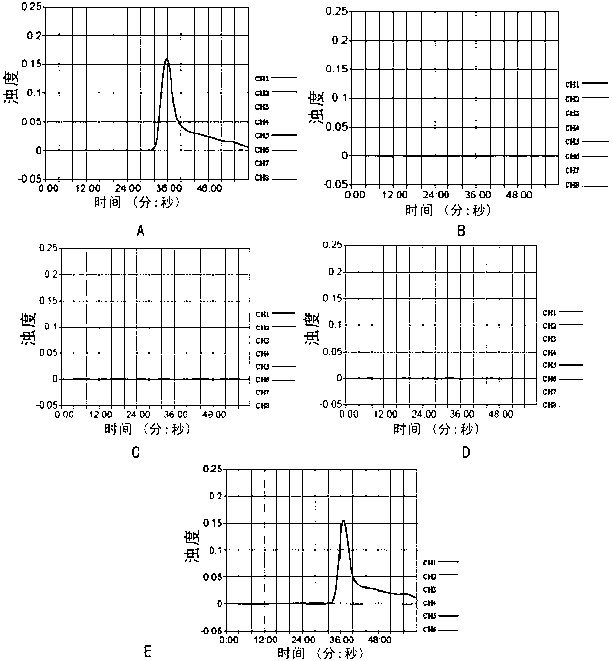Food allergen lupin component LAMP (loop-mediated isothermal amplification) field quick detection method
A lupin and allergen technology, applied in the fields of molecular biology and nucleic acid detection, can solve problems such as low equipment requirements
- Summary
- Abstract
- Description
- Claims
- Application Information
AI Technical Summary
Problems solved by technology
Method used
Image
Examples
Embodiment 1
[0105] Example 1. Preliminary screening and system optimization of food allergen lupine component-specific detection primers
[0106] Preliminary determination of 25 μL LAMP reaction system, its components include: 1.6 μM each of FIP and BIP, 0.2 μM each of F3 and B3, 20 mM Tris-HCl (PH8.8), 10 mM KCl, 8 mM MgSO 4 , 10mM (NH 4 ) 2 SO 4 , 0.1%Tween20, 1M Betaine, 6mM MgSO 4 , 1.6mM dNTP, 8U Bst large fragment DNA polymerase, 2μl DNA to be tested. React at a constant temperature of 63°C for 90 minutes, then incubate at 80°C for 5 minutes to end the reaction, and preliminarily screen primers according to the peak time and the coincidence rate of negative and positive. 100% lupine standard was used as a template for the primary screening of primers, and negative DNA was used as a negative control. Experimental result shows, this primer begins to appear amplification in 30min ( figure 1 ).
[0107] Optimization of LAMP reaction conditions: selection of Mg 2+ Concentration o...
Embodiment 2
[0109] Example 2. Specific detection experiment of food allergen lupine component LAMP
[0110] Allergen primers were used to perform LAMP amplification on the 36 kinds of plant and animal materials tested. After the LAMP real-time turbidimeter detection, the yellow-flowered lupine and the white-flowered lupine showed obvious amplification curves, while the remaining 34 kinds of animal and plant samples There is no amplification curve in any of them, such as image 3 .
[0111] According to the real-time turbidity detection results of the specific detection of food allergen lupine component LAMP, the above-mentioned test materials were tested by chromogenic LAMP, and the results showed that the reaction liquid of yellow flower lupine and white flower lupine was green, and the DNA of other animal and plant materials The reaction solution is orange, such as Figure 4 .
[0112] The results of real-time turbidimeter LAMP detection and chromogenic LAMP detection showed that the...
Embodiment 3
[0113] Example 3. LAMP Detection Sensitivity of Allergen Lupine Components
[0114] Mix pure white lupine flour and wheat flour by weight to form a mixed sample with lupine content of 1%, 0.1%, 0.05%, 0.01%, 0.005%, 0.001% and 0.0005%, and extract DNA for LAMP detection. Each concentration was repeated 3 times, and the results were recorded with a real-time turbidimeter. The results of real-time turbidity LAMP detection showed that 1%, 0.1%, 0.05%, 0.01%, 0.005%, and 0.001% lupine all had amplification curves, but 0.0005% lupine did not. As a result, the detection limit of this assay was 0.001%, as Figure 5 .
[0115] According to the real-time turbidity detection results of the sensitivity detection of food allergen lupine component LAMP, 0.1% lupine, 0.001% lupine, 0.0005% lupine and 0% lupine samples were detected by LAMP chromogenic method. The test results of LAMP colorimetric method showed that 0.1% lupine, 0.001% lupine had color reaction, and 0.0005% lupine had no ...
PUM
 Login to View More
Login to View More Abstract
Description
Claims
Application Information
 Login to View More
Login to View More - R&D
- Intellectual Property
- Life Sciences
- Materials
- Tech Scout
- Unparalleled Data Quality
- Higher Quality Content
- 60% Fewer Hallucinations
Browse by: Latest US Patents, China's latest patents, Technical Efficacy Thesaurus, Application Domain, Technology Topic, Popular Technical Reports.
© 2025 PatSnap. All rights reserved.Legal|Privacy policy|Modern Slavery Act Transparency Statement|Sitemap|About US| Contact US: help@patsnap.com



